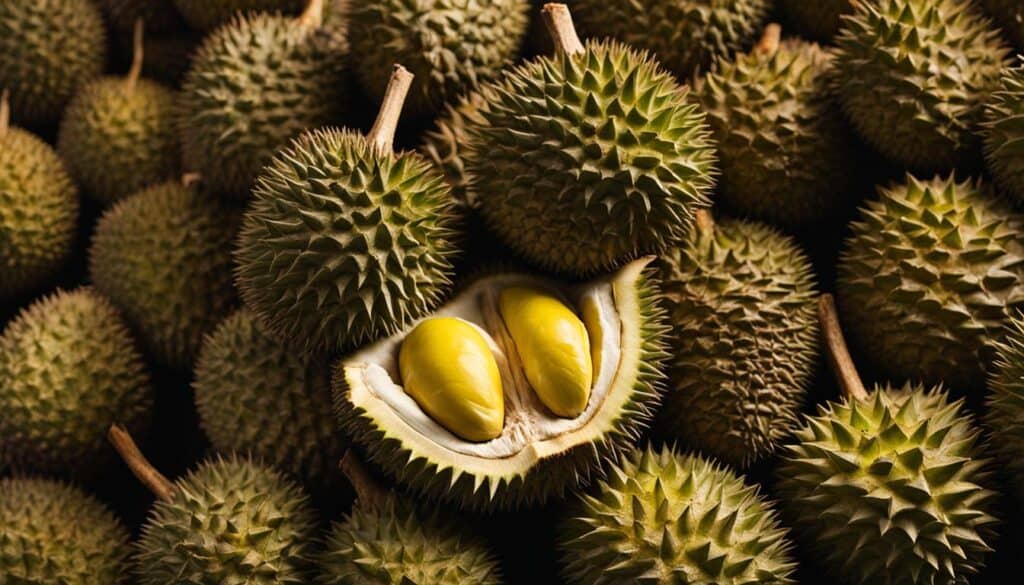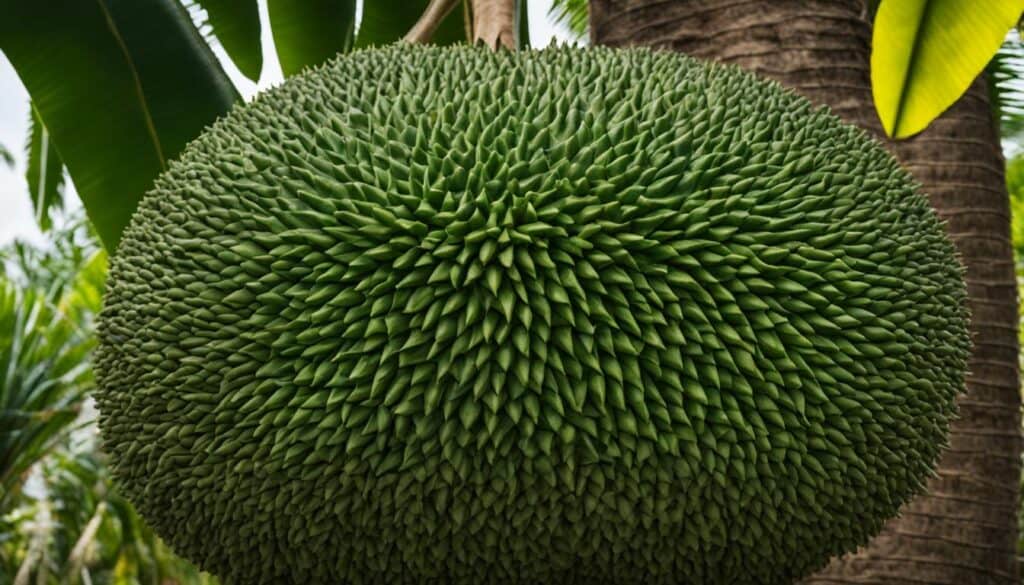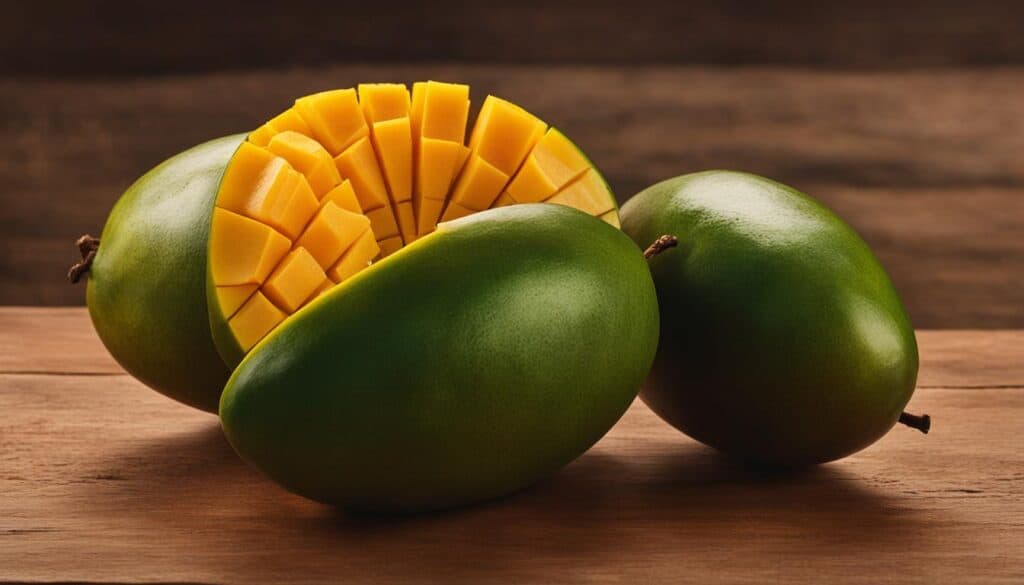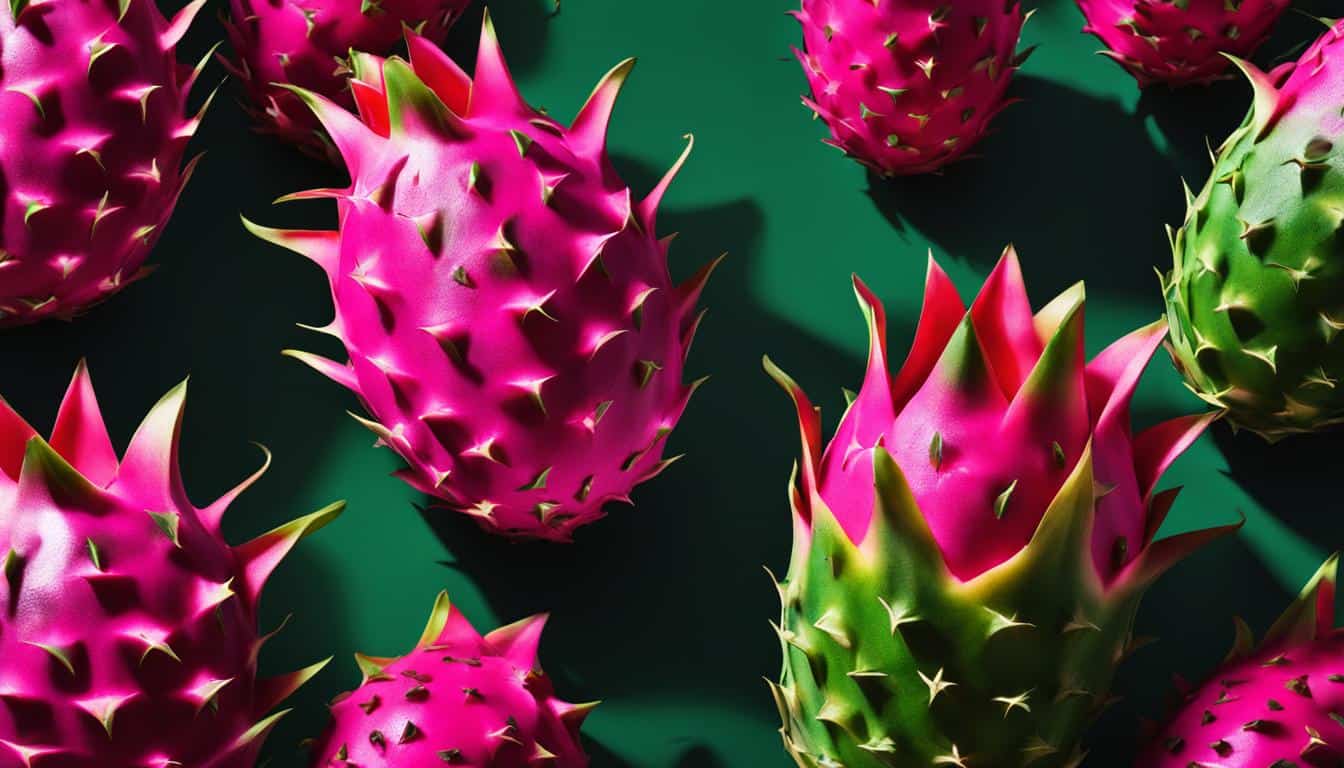Greetings, fruit enthusiasts! Join me on a flavorful journey as I delve into the world of fruits similar to soursop. Whether you’re searching for soursop alternatives, fruits with comparable flavors, or soursop substitutes for your favorite recipes, I’ve got you covered. Get ready to tantalize your taste buds with tropical delights and discover a whole new world of fruity goodness!
During my taste adventure, I stumbled upon some truly intriguing options that closely resemble the exotic soursop. From custard apples to cherimoyas, these fruits boast fragrantly tropical tastes that will transport you to paradise. With their custard-like textures and flavors that blend vanilla, pineapple, banana, and passionfruit, soursops and custard apples take the crown. But don’t stop there! Dragonfruit, durian, jackfruit, mangosteen, rambutan, lychee, and pomegranate also offer unique flavors and can be enjoyed as alternatives or substitutes for soursop in recipes, or savored on their own.
With a world of possibilities at your fingertips, why not embark on this taste adventure and introduce your palate to the wonders of fruits similar to soursop? Trust me, it’s a journey that you won’t regret!
Key Takeaways:
- There are several fruits similar to soursop that offer unique tropical flavors and textures.
- Custard apples, dragonfruit, durian, jackfruit, and tropical fruits from Southeast Asia are excellent alternatives to soursop.
- Exploring these fruits expands your culinary horizons and adds variety to your diet.
- Each fruit offers its own health benefits and can be enjoyed on its own or incorporated into various recipes.
- Embark on this taste adventure and discover your new favorite fruit!
Custard Apple – a Velvety Tropical Delight
When it comes to tropical fruits similar to soursop, custard apples are a delightful option. These fruits belong to the cherimoya family, which also includes soursops. With a texture akin to custard and a captivating fragrance, custard apples offer a unique taste experience.
The flavor profile of custard apples can be best described as a delightful combination of vanilla, pineapple, banana, and passionfruit. While they are slightly less sweet than soursops, custard apples still provide a burst of tropical goodness.
The soft flesh of custard apples is studded with large seeds that are easily removable. You can simply scoop out the flesh or cut it into quarters, just like you would with an apple. The versatility of custard apples allows you to enjoy them in various ways.
“Custard apples have a texture similar to custard and a fragrant tropical flavor that can be described as a combination of vanilla, pineapple, banana, and passionfruit.”
One way to relish custard apples is by enjoying them straight out of the skin. The creamy flesh provides a velvety mouthfeel as you savor the tropical flavors. For an added twist, drizzle the fruit with a squeeze of lime juice to enhance its bright and tangy notes.
For a more indulgent treat, you can blend custard apples with coconut milk or pineapple juice to create tropical delights like custard apple ice cream or refreshing custard apple cocktails.
To summarize, custard apples offer a velvety texture, a fragrant tropical flavor, and a myriad of uses. Whether enjoyed on their own or incorporated into creative recipes, custard apples are a tropical delight that will transport your taste buds to sun-kissed paradise.
Comparing Soursop and Custard Apple
| Aspect | Soursop | Custard Apple |
|---|---|---|
| Flavor | Tropical blend of citrus, pineapple, and strawberry | Fragrant combination of vanilla, pineapple, banana, and passionfruit |
| Texture | Creamy and smooth | Soft and custard-like |
| Seeds | Small seeds embedded within the flesh | Large seeds easily removable from the flesh |
| Uses | Enjoyed fresh, blended in smoothies, used in desserts | Straight out of the skin, drizzled with lime juice, blended with coconut milk or pineapple juice |
Dragonfruit – A Vibrant and Refreshing Option
When it comes to fruits similar to soursop, dragonfruit is a standout choice. Also known as pitahaya or pitajaya, this visually striking fruit has a thick outer skin and boasts a vibrant and refreshing flavor that can delight your taste buds. With its unique appearance and tropical taste, dragonfruit is a must-try for fruit enthusiasts.
The flavor of dragonfruit is often described as a cross between a pear and a guava, with a refreshing sweetness and a mild tartness. Its inner flesh is deliciously sweet, making it a perfect option for those craving a unique and enjoyable fruity experience. The flesh is dotted with small black seeds, adding a delightful crunch to every bite.
Dragonfruit is versatile and can be enjoyed in various ways. Whether you prefer to eat it fresh, blend it into smoothies, or incorporate it into creative recipes, dragonfruit can add a burst of flavor and visual appeal to your culinary creations. Its vibrant colors, which range from white to pink to red, make it a stunning ingredient for fruit bowls, salads, and desserts.
If you’re looking to experiment with dragonfruit in your kitchen, there are plenty of enticing recipes to try. Its mild and slightly tangy flavor pairs well with other fruits, making it a great addition to smoothie bowls or fruit salads. You can also use dragonfruit as a garnish or topping for cakes, pastries, or cocktails, adding a touch of tropical elegance to your creations.
“Dragonfruit’s vibrant colors and unique taste make it an excellent choice for those seeking a refreshing and visually appealing fruit. Its versatility and delicious flavor open up a world of culinary possibilities.”
Adding dragonfruit to your diet not only introduces new and exciting flavors but also provides essential nutrients. Dragonfruit is rich in antioxidants, fiber, and vitamin C, making it a healthy and refreshing addition to your daily routine. So, why not give dragonfruit a try and embark on a delightful journey of taste and texture?
Durian – A Unique and Acquired Taste
When it comes to unique fruits, durian takes the crown. This highly prized fruit is a standout in Southeast Asia and can also be found in Latin America. With its spiky exterior and distinctive smell, durian is no ordinary fruit. While the pungent aroma may be off-putting to some, those who can look past it are in for a treat.
What sets durian apart is its creamy and custard-like texture. The flesh of the fruit is rich and smooth, offering a truly indulgent experience. But it’s not just the texture that makes durian special; it’s the flavor as well.
Durian is often described as having a combination of sweet, savory, and slightly nutty flavors. It’s a taste that is truly unique and can only be fully appreciated by those who have developed a fondness for it. Some even compare the flavor to a blend of caramel, custard, and hints of tropical fruits.
“Durian has a distinct flavor that you won’t find in any other fruit. It’s an acquired taste, but once you acquire it, you’ll find it hard to resist.” – Durian enthusiast
While durian may not be for everyone, it does come with its fair share of health benefits. This tropical fruit is packed with nutrients, including vitamins, minerals, and beneficial plant compounds. It is a good source of vitamin C, fiber, and antioxidants, which can help boost the immune system, improve digestion, and protect against oxidative stress.
If you’re feeling adventurous and willing to explore new flavors, durian is definitely worth a try. Just be prepared for a unique sensory experience that is sure to leave a lasting impression.
At a Glance: Durian
| Taste | Texture | Smell | Health Benefits |
|---|---|---|---|
| Sweet, savory, slightly nutty | Creamy and custard-like | Distinct and pungent | Packed with nutrients, vitamins, and antioxidants |

So, if you’re ready to embark on a taste adventure like no other, give durian a chance. Its unique flavors, creamy texture, and potential health benefits make it a fruit worth exploring. Just remember, this tropical delight is an acquired taste that may not be for everyone. But for those who dare to embrace it, the rewards are truly extraordinary.
Jackfruit – A Tropical Delight
When it comes to fruits similar to soursop, jackfruit has gained significant popularity. This tropical delight, commonly found in Southeast Asia and Latin America, offers an enticing combination of taste and texture.
Unlike its odoriferous cousin, durian, jackfruit has a milder aroma and a distinctly different flavor profile. The fruit boasts a fibrous and meaty texture that sets it apart. Its taste is mildly sweet, making it a versatile ingredient in a variety of dishes.
One of the unique aspects of jackfruit is its ability to serve as a meat substitute in vegetarian and vegan culinary creations. Its fibrous texture mimics the consistency of pulled pork or shredded chicken, making it an excellent option for barbecue-style sandwiches or tacos.
In addition to its culinary uses, jackfruit offers numerous health benefits. It is rich in vitamin C, which supports immune function and aids in collagen production. Jackfruit is also a good source of dietary fiber, promoting digestive health and keeping you feeling full and satisfied.
Whether you enjoy jackfruit fresh, cooked, or as a meat substitute, it serves as a tasty alternative for those seeking fruits similar to soursop. Its unique texture, mild sweetness, and health benefits make it a tropical delight worth exploring.

| Jackfruit | |
|---|---|
| Taste | Mildly sweet |
| Texture | Fibrous and meaty |
| Uses | Culinary: meat substitute, fresh consumption, cooking |
| Health Benefits | Good source of vitamin C and dietary fiber |
Tropical Delights from Southeast Asia
Southeast Asia is a treasure trove of tropical fruits that tantalize the taste buds with their exotic flavors. If you’re searching for fruits similar to soursop, look no further than the bountiful offerings from this vibrant region. Let me introduce you to some Southeast Asian fruits that will transport you to a tropical paradise.
Mangosteen: The Queen of Tropical Fruits
The mangosteen, often referred to as the “Queen of tropical fruits,” is a true gem of Southeast Asia. With its vibrant purple rind and luscious white flesh, the mangosteen offers a delightful blend of flavors. Imagine the tang of pineapple, the creaminess of cherimoya, and the zesty notes of tangerine—all wrapped up in one delicious fruit.
Longan: Jelly-like Texture and Tart-Sweet Taste
Longan is another Southeast Asian fruit that shares similarities with soursop. This small, round fruit has a translucent jelly-like texture and a unique flavor profile. With each bite, you’ll experience a tart-sweet taste that is both refreshing and satisfying. Longan is a tropical delight that will leave you wanting more.
Rambutan: Colorful and Hairy with Lychee-like Flavor
Rambutan is a tropical fruit that is hard to miss with its vibrant red exterior covered in soft spines. Peel back the hairy skin to reveal a translucent fruit with a taste reminiscent of lychee. The sweet, juicy flesh of the rambutan is sure to captivate your taste buds and transport you to a world of tropical bliss.
Lychee: Sweet Juiciness in Every Bite
If you’re searching for a popular Southeast Asian fruit, look no further than the lychee. With its sweet and juicy flesh, the lychee is a tropical delight that will leave you craving more. Peel away the rough skin to reveal a tender and flavorful fruit that is perfect for enjoying on a hot summer day.
Indulge in the tropical flavors of Southeast Asia with these incredible fruits. Whether enjoyed on their own or incorporated into recipes, mangosteen, longan, rambutan, and lychee will transport you to a world of tropical bliss. So, take a bite and savor the exotic flavors that these Southeast Asian fruits have to offer.
Persimmon – A Unique and Tasty Fruit
I have always been intrigued by the diverse range of fruits found around the world. One fruit that has captured my attention is the persimmon. This delicious fruit is enjoyed in various parts of the world, including the United States and Asia. Persimmons come in different varieties, but two popular ones are the crispy persimmon (fuyu) and the soft persimmon (hachiya).
The crispy persimmon, also known as fuyu, has a texture that is similar to that of a nectarine. It is firm and can be enjoyed when slightly ripe. The soft persimmon, on the other hand, is known as hachiya, and it should be consumed when it becomes soft and almost overripe. Each variety offers a unique experience in terms of taste and texture.
“Persimmons have a unique taste that is often described as sweet and flavorful.”
When it comes to taste, persimmons have a wonderful sweetness that is complemented by a rich and flavorful profile. Their delightful taste has made them a favorite among fruit enthusiasts. Whether eaten fresh or used in various recipes, persimmons add a unique touch to every dish.
If you’re curious about the taste of persimmons and want to try them for yourself, here is a simple recipe:
- Peel and slice a ripe persimmon into bite-sized pieces.
- Arrange the persimmon slices on a plate.
- Sprinkle a dash of cinnamon on top for added flavor.
- Enjoy the sweet and juicy goodness of persimmons!
Whether you prefer the crispy texture of the fuyu persimmon or the soft and lusciousness of the hachiya persimmon, these fruits are sure to satisfy your taste buds.

Persimmon Varieties Comparison
| Persimmon Variety | Texture | Taste |
|---|---|---|
| Crispy Persimmon (Fuyu) | Crisp, similar to a nectarine | Sweet and flavorful |
| Soft Persimmon (Hachiya) | Soft and luscious | Sweet and rich |
Persimmon Recipe – Persimmon Salad
For a refreshing and vibrant salad, try this delicious persimmon recipe:
- Ingredients:
- 2 crispy persimmons (fuyu)
- Mixed greens
- Goat cheese
- Pecans
- Balsamic vinaigrette dressing
- Instructions:
- Thinly slice the crispy persimmons.
- Place the mixed greens on a plate.
- Top with the sliced persimmons, crumbled goat cheese, and pecans.
- Drizzle with balsamic vinaigrette dressing.
- Toss gently to combine all the ingredients.
- Serve and enjoy the delightful combination of flavors!
Whether you enjoy persimmons on their own, in salads, or in other culinary creations, this unique fruit is sure to add a touch of sweetness and flavor to your meals.
Pomegranate – Bursting with Flavor and Nutrients
When it comes to fruits that are not only delicious but also packed with nutrients, pomegranates are a clear winner. These vibrant fruits are enjoyed in various parts of the world for their unique taste and numerous health benefits.
The outer shell of a pomegranate is usually yellow to reddish in color, while the inside is filled with juicy, white to red seeds. These seeds, also known as arils, are not only visually appealing but also bursting with flavor.
Whether you munch on them straight from the fruit or add them as a topping to salads and desserts, pomegranate seeds provide a delightful burst of sweetness and tanginess to any dish. Their juicy texture adds a refreshing element and enhances the overall flavor profile.
| Pomegranate Health Benefits | Pomegranate Uses |
|---|---|
|
|
Aside from their incredible taste and versatility in the kitchen, pomegranates offer a wide array of health benefits. So why not make them a regular part of your diet and enjoy their delicious flavor while reaping their nutritious rewards?

Mango – The King of Fruits
When it comes to tropical fruits, mangoes reign supreme. Known as the “King of Fruits,” mangoes are beloved for their delicious flavor and versatility. One variety of mango that stands out is the alphonso mango, which is highly sought after for its unique taste.
The alphonso mango boasts a sweet and creamy flavor with subtle hints of citrus and tropical notes that make it truly exceptional. Its rich and luscious taste is unmatched, making it a favorite among mango enthusiasts.
With its smooth and velvety texture, the alphonso mango offers a delightful eating experience. Whether enjoyed fresh, sliced into desserts, or blended into refreshing smoothies, this mango variety adds a burst of natural sweetness to any dish.
Aside from its incredible flavor and texture, mangoes can be used in a variety of culinary creations. From salads to salsas, curries to chutneys, mangoes lend their unique taste to a wide range of dishes.
Let’s explore some of the uses of mangoes:
| Uses of Mango |
|---|
| Mango salsa |
| Mango smoothies |
| Mango salads |
| Mango chutney |
| Mango desserts |
No matter how you choose to enjoy mangoes, their vibrant flavor and delightful texture are sure to please your taste buds. Plus, mangoes are a nutritional powerhouse, packed with essential vitamins and minerals, including vitamin C and fiber.

The Importance of Variety in a Healthy Diet
Incorporating a variety of fruits into our diet is essential for maintaining a healthy lifestyle. Different fruits offer diverse nutritional benefits and flavors, ensuring that we get a wide range of essential nutrients for optimal health.
A balanced diet that includes diverse fruits enables us to experience new tastes and broaden our culinary horizons. It adds excitement to our meals and enhances our overall dining experience. By exploring fruits similar to soursop, we can expand our palate and discover a whole new world of flavors and textures.
When we include a variety of fruits in our diet, we not only improve our own well-being but also support local farmers and contribute to sustainable agricultural practices. By choosing different fruits from local sources, we help promote the growth of diverse crops and reduce our carbon footprint.
“A diet rich in diverse fruits provides our bodies with a wide array of nutrients, vitamins, and minerals necessary for good health.”
The Nutritional Benefits of Diverse Fruits
Each fruit offers its unique set of nutritional benefits. By consuming a variety of fruits, we ensure that we receive a broad spectrum of essential nutrients, such as:
- Vitamin C: Found abundantly in fruits like oranges, strawberries, and kiwis, vitamin C boosts our immune system and supports healthy skin.
- Vitamin A: Fruits like mangoes, cantaloupes, and apricots are rich in vitamin A, which is essential for good vision and maintaining healthy skin and mucous membranes.
- Dietary fiber: Fruits such as apples, pears, and berries are excellent sources of dietary fiber, which aids digestion and helps regulate blood sugar levels.
- Antioxidants: Many fruits, including blueberries, pomegranates, and grapes, are packed with antioxidants that protect our cells from damage and promote overall health.
By including a variety of fruits in our diet, we can ensure that we receive a full spectrum of these essential nutrients, supporting our overall well-being.
A Visual Feast: Exploring Diverse Fruits
To better understand the variety of fruits available, let’s take a look at some examples:
| Fruit | Nutritional Benefits | Flavor |
|---|---|---|
| Mango | High in vitamin C and A | Sweet and tropical |
| Dragonfruit | Rich in antioxidants and vitamin C | Refreshing and mildly sweet |
| Pineapple | Contains bromelain for digestion | Refreshing with a hint of tanginess |
| Kiwi | Packed with vitamin C and dietary fiber | Tangy and refreshing |
As you can see, each fruit offers a unique combination of nutritional benefits and flavors. By incorporating a variety of these fruits into our diet, we can create visually appealing and delicious meals.
Conclusion
Embarking on a taste adventure to explore fruits similar to soursop has been a delightful journey filled with unique flavors and healthy alternatives. From custard apples to dragonfruit, durian to jackfruit, there is a diverse range of options to tantalize your taste buds. These fruits not only offer a variety of tastes and textures but also provide numerous health benefits.
Whether enjoyed fresh, blended into smoothies, or used in recipes, fruits similar to soursop add a tropical and refreshing touch to your culinary creations. The custard apples with their creamy texture, the vibrancy of dragonfruit, the distinct taste of durian, and the tropical delight of jackfruit all offer a taste adventure like no other. These fruits can be used as excellent alternatives and substitutes for soursop, allowing you to explore new and exciting flavors in your favorite recipes.
By incorporating diverse fruit options into your diet, you not only add a burst of flavor but also ensure a balanced and nutritious intake. Fruits similar to soursop are not only tasty but also rich in vitamins, minerals, and antioxidants. So, why not indulge in this culinary exploration and enjoy the unique flavors and healthy alternatives that these fruits have to offer?
FAQ
Are there any fruits similar to soursop?
Yes, there are several fruits that are similar in taste and texture to soursop.
What fruits have a custard-like texture like soursop?
Custard apples, also known as cherimoya, have a custard-like texture similar to soursop.
What do custard apples taste like?
Custard apples have a fragrant tropical flavor that combines vanilla, pineapple, banana, and passionfruit.
Can dragonfruit be a substitute for soursop?
Dragonfruit is a refreshing option that can be used as an alternative to soursop in recipes or enjoyed on its own.
What is the flavor of dragonfruit?
Dragonfruit has a sweet and mildly tart taste, with flavors that resemble a cross between a pear and a guava.
Is durian similar to soursop?
Durian is a unique fruit that has a creamy and custard-like texture. While it has a distinct flavor, it can be enjoyed as an alternative to soursop.
Does jackfruit taste similar to soursop?
Jackfruit has a fibrous and meaty texture with a mildly sweet flavor. While it is different from soursop, it can be a tasty option as a fruit substitute.
Are there any tropical fruits similar to soursop?
Yes, there are several tropical fruits from Southeast Asia, such as mangosteen, longan, rambutan, and lychee, that have flavors similar to soursop.
What are the taste differences between crispy and soft persimmons?
Crispy persimmons have a texture similar to a nectarine and a sweet and flavorful taste. Soft persimmons have a softer texture and are sweeter when they are fully ripe.
What does pomegranate taste like?
Pomegranates have a sweet and tangy flavor that adds a burst of freshness to any dish.
Can mango be a substitute for soursop?
Mangoes have a rich and unique flavor, and while they are different from soursop, they can be enjoyed as an alternative.
Why is it important to have variety in our diet?
Having variety in our diet ensures that we get a diverse range of nutrients and flavors, supporting our overall health and well-being.





Leave a Reply